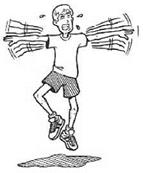When Air’s Not There
The rare air at high altitude can take a toll on pilots. In extreme conditions, for example at altitudes above 10,000 feet, the thin air starts affecting the way the body operates.
|
By the Book Hemoglobin is the molecule in red blood cells that picks up oxygen in the lungs and carries it to the parti of the body that need it |
The ability of the blood to carry oxygen to the body’s cells, most importantly to the brain cells, is directly related to how much oxygen is carried in the blood’s hemoglobin.
Doctors describe the lack of oxygen as hypoxia. Hypoxia is a catch-all term that is associated with a number of maladies and conditions, from dizziness to
stroke. In the cockpit, we’re usually concerned with four kinds of hypoxia: anemic, histotoxic, stagnant, and hypoxic. (Yes, I agree that hypoxic hypoxia sounds repetitively redundant, but that’s what physicians call it.) Here’s a brief description of each:
• Anemic hypoxia happens when the blood has too little hemoglobin. Even if anemia doesn’t cause problems by itself, such as the shortness of breath and lightheadedness that a doctor might be concerned about, it can add to the problems caused by other types of hypoxia.
• Histotoxic hypoxia happens when another substance fills the hemoglobin molecule, robbing it of its ability to carry oxygen. Alcohol and carbon monoxide can bring on this form of hypoxia.
|
Turbulence Cigarette smoke contains carbon monoxide. In fact pilots who smoke walk around in a perpetual state of histotoxic hypoxia. The poisoning of the blood makes the body feel as though it’s 5,000 feet higher than it is, at least in terms of the amount of oxygen carried by the hemoglobin. |
|
Turbulence It’s logical that too little air can be dangerous, but what about too much air? Yes, hyperoxia, or as it’s better known, hyperventilation, can cause trouble in the cockpit Rapid breathing, usually caused by anxiety and common among beginning student pilots, overfills the blood with oxygen and can cause fainting if it goes on too long. The cure is simply to consciously slow your breathing rate. |
• Stagnant hypoxia occurs when a pilot pulls high g-forces that happen during steep turns or in aerobatic maneuvers. During high g maneuvers, the blood rushes away from the head and brain and pools in the feet and rear end.
Experienced pilots use the muscles in their neck and chest to try to prevent the blood from leaving their head. In what the military cryptically calls the “L1 maneuver,” pilots strain their neck and chest muscles, which sometimes causes a grimacing facial expression. When they are contracted, the muscles pinch off the blood vessels that pass through them, preventing the blood from moving through too quickly and causing it to stay longer in the brain, where it’s needed.
• The most threatening kind of hypoxia for pilots is the hypoxic variety. As atmospheric pressure drops, so does the partial pressure of oxygen. When the partial pressure can no longer fully saturate the hemoglobin, the body starts to slowly suffocate. The brain, which uses the largest proportion of oxygen, suffers the most.
|
Plane Talk I was fortunate enough to spend a day at Williams Air Force Base in Arizona experiencing the effects of high altitudes. Inside a sealed pressure chamber, technicians gradually pumped the air out of the chamber unb’l we were at simulated altitudes that went as high as 20,000 feet or so. The purpose of the training was for pilots to recognize the individual patterns of symptoms. My first symptoms were a tingling in my fingers, numbness in my lips, a dimming of vision, and a sensation of anxiety. I also discovered that, although I was in excellent condition, my tolerance for high altitudes was far less than many of the less fit and older pilots who were with me in the chamber. |
Hypoxic hypoxia is dangerous because the first symptoms are often difficult for a pilot to detect. To make matters worse, the first symptom is sometimes euphoria, a sensation that everything’s just fine. In fact, unless the pilot descends to a lower altitude quickly, or puts on an oxygen mask that feeds pure oxygen, the hypoxia is likely to get worse. If something’s not done to get more oxygen to the brain, hypoxia can be fatal.
|
On Course I once had a friend who managed, by flying mostly in the morning when the air was calm, to make it almost all the way through his airline pilot training despite the fact that he suffered from extreme, chronic airsickness. It was when he was in his final phase of training that an instructor put two and two together. My friend’s airline hopes came to an end, all because of a case of incurable airsickness. |
Hypoxic hypoxia often causes blue lips, blue finger-nails, tunnel vision, and shortness of breath. Pilots are taught to recognize these dangerous warning signs before disaster strikes.





























